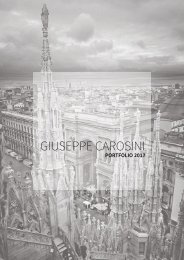You also want an ePaper? Increase the reach of your titles
YUMPU automatically turns print PDFs into web optimized ePapers that Google loves.
RECREATION AND LEISURE<br />
Recreation and leisure are almost never mentioned in the context<br />
of a refugee camp. In UNCHR’s Handbook for Emergencies, which is<br />
widely used for planning refugee camps, these aspects of human life<br />
are mentioned nowhere. In fact, they may be intentionally omitted<br />
because they are considered disrespectful in a situation of desperation.<br />
The support systems and protocols address only basic survival,<br />
and are limited to the provision of food and medications.<br />
By contrast, Sahrawi districts provide spaces for various social activities:<br />
weddings, tea ceremonies, and distribution centers that convert<br />
into places for socializing, meeting and playing. Cultural activities,<br />
such as youth theaters and painting, are also widely encouraged.<br />
Inhabitants of this enhanced camp are also encouraged to pursue<br />
sports. Football is the favourite and is played almost everywhere,<br />
from empty spaces between dwellings to proper football fields located<br />
in the center of each camp.<br />
97 LIFE IN LIMBO<br />
Camps<br />
The camp spreads as new refugees<br />
arrive. The tents are replaced or<br />
supplemented by huts. Initially<br />
rigid organization changes to a<br />
more fluid or informal layout. Some<br />
families, needing additional space,<br />
move to the periphery of the camp<br />
which results in blurring of the<br />
camp’s borders.<br />
Urban fabric<br />
Rigid order of tents gets dissolved<br />
and a more ‘‘organic’’ organization<br />
begins to emerge. Starting with<br />
single huts, households build new<br />
additional objects. More recently,<br />
these objects are surrounded by<br />
walls creating enclosed courtyards,<br />
separating in that way private from<br />
public space.<br />
Housing Typologies<br />
When camps were established, the<br />
refugees used to live in tents that<br />
are donated by Algerian government<br />
following the ones donated<br />
by UNHCR . Later they build clay<br />
huts and more recently the ones<br />
made of cement bricks. All typologies<br />
are still present in the camps<br />
nowadays.




